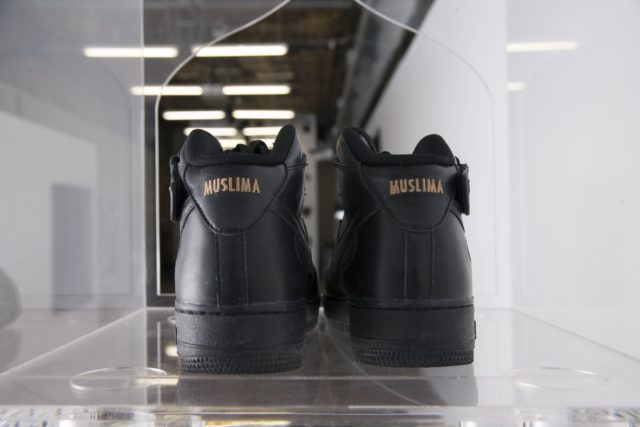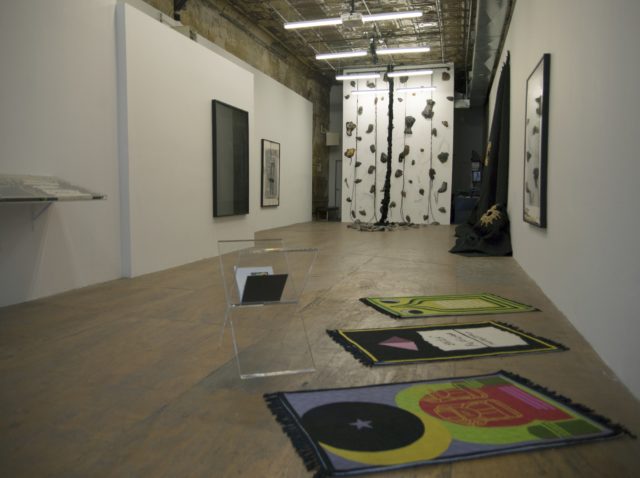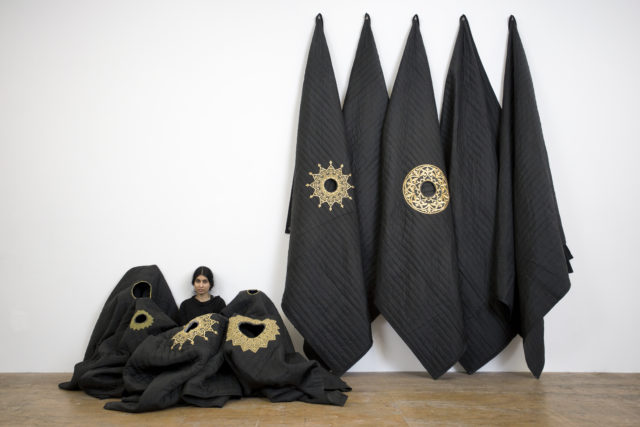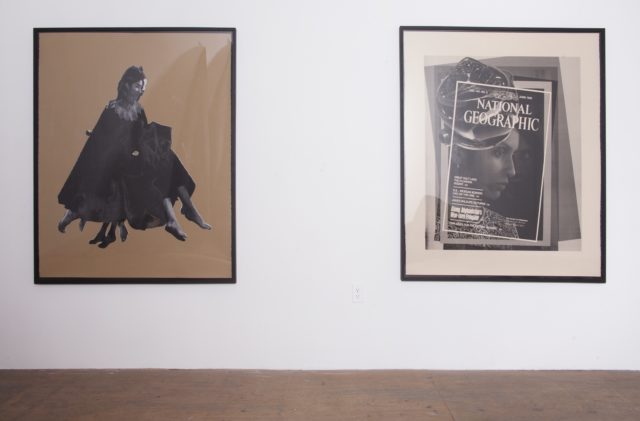
Baseera Khan, iamuslima, Nike ID Tag customized Nike Air Force One Mid-top shoes (Courtesy the artist)
Baseera Khan: iamuslima
Participant Inc.
253 East Houston Street
New York, NY
On view until April 2, 2017
The personal is political is one of the longest enduring clichés in contemporary art. But, sometimes, an artist can dust off this tiresome trope to more effectively shed light on a critical issue with their own life and cultural heritage than with cold, hard facts.
The latest of these exhibitions is Baseera Khan’s iamuslima at Participant Inc. The show does more than just counter our current environment of Muslim bans and government-sanctioned discrimination. Instead, the artist takes aim at its historical legacy by referencing her and her family’s experiences.
And this could explain why the show felt much more successful than others launched in response to Trump’s Executive Orders. Unlike MoMA’s fifth floor rehanging, it doesn’t just drag out disparate paintings by Muslim artists–inadvertently raising questions about why they were in storage for decades. Here, Khan presents a visceral, personal depiction of the tenuous place of Muslim women in Western culture.

Installation view of Baseera Khan’s “iamuslima” at Participant Inc. (Courtesy the artist)
Overall, Khan’s white-walled exhibition is sparsely hung, with works scattered around the space. With its central climbing wall and bookshelf of suggested reading material, it looks like a playground for art-goers. However, what the show lacks in organizational density, it makes up for in layers of Islamic symbolism. This includes a series of colorful prayer rugs facing northeast and five large-scale black-and-white prints based on Khan’s interpretation of the Five Pillars of Islam (here: prayer, pilgrimage, oneness, zakat (charity) and fasting).
This gallery-wide immersion into Islamic visual culture immediately confronts viewers with Muslims’ fragile position in Western society. The first thing viewers see, after walking through the doors, is a pair of black Nike Air Force One sneakers, placed on a set of shelves containing books by Frantz Fanon, Jean Genet and others on post-colonialism, race and migration. The shoes are emblazoned with the word “Muslima” in gold. This misspelling isn’t a mistake. Instead, it’s a forced rearrangement of the word Muslim in order to be approved by Nike’s customizing NikeiD program (unsurprisingly, other religious terms were allowed). Khan wasn’t the only person to discover this–Nike was sued (and lost) over their rejection of “Muslim.”

Installation view of Baseera Khan’s Braidrage at Participant Inc. (Courtesy of the artist)
While the shoes present an eye roll-inducing example of the pervasive fear of Islam, Khan’s critique comes into focus when she engages with the generations of Muslim bodies that came before her. This can be seen in the monumental installation Braidrage. Khan transforms the central wall in the gallery into a climbing wall, but instead of the rock-like steps in a gym, she fashioned steps from fractured cast resin body parts. Torsos, feet, ankles, elbows and knees, in different shades of brown are arranged from the floor up, hanging at various levels on the wall. The installation resembles a wave of dismembered or blown-up bodies. Gold chains weave through the limbs like veins and shiny metallic warming blankets add a glittering glow. It’s hard not to look at the installation without thinking of drone strikes or terrorist attacks
But beyond the potential violence, understanding Braidrage as an active climbing wall deepens her statement. An enormous braid hangs in the middle of the installation with smaller braids and gold chains closer to the wall, acting as a harness for climbing (Khan, in an opening performance, scaled the wall in her Nike sneakers). Rather than just a fractured body, modeled after the artist’s own, the installation represents the bodies and histories of other Muslim women that Khan stands on today. It seems to indicate the trauma she, and others, must negotiate and climb.

Baseera Khan, Acoustic Sound Blankets, sound dampening material used in sound recording labs with custom designed embroidered neck holes (Courtesy the artist; Photo by Maxim Ryazansky)
More than just anonymous body parts, other works use imagery directly descendent from her own family to point to the ways Muslims have historically had to code language and symbols in order to shield themselves from violence. Take, for example, her collection of Acoustic Sound Blankets. These heavy black blankets feature a single hole embroidered with an elaborate gold pattern, which derives from imagery passed down through generations of women in Khan’s family. Five blankets are draped on the walls, while six sit propped on the floor, eerily reminiscent of sitting or kneeling bodies. Resembling both a protective covering, as well as a burka, the blankets seem to reflect how practices of safety, like aesthetics, connect generations.

Baseera Khan’s Oneness and Zakat, monotone screen-prints on Stonehenge paper (Courtesy the artist)
Granted, like her Acoustic Sound Blankets, some of Khan’s work requires close reading of the press release for context, especially for viewers with passing knowledge of Islamic or South Asian symbolism. This is why the inclusions that are, perhaps, more obvious come across as more impactful. A good example of this is Khan’s black-and-white print Zakat. In this work, Khan appropriates the notorious 1985 National Geographic cover with Steven Curry’s photograph of an Afghani girl. With her piercing gaze, this photograph will be recognizable to many viewers since it still stands as the typical clichéd depiction of refugees. Khan also keeps the photograph’s subtitle, which reads, “haunted eyes tell of an Afghan refugee’s fears.” Rather than just letting that cringe-worthy sappiness stand, Khan adds the phrase “words of whiteness,” emphasizing the white gaze of the photographer (and possibly, the viewer) that perceives this Afghani girl as a traumatized victim. In the same print, Khan superimposes an image of herself in profile over the cover, combining her experience as a Muslim woman in America with the Afghani girl’s.
Even more chilling than the continued objectification of Muslim women, however, are the magazine’s headlines. This includes “U.S. Mexican Border: Life on the Line” and “Afghanistan’s War Torn Frontier.” Both are issues that still resonate today. While we sometimes like to think with the Muslim ban that we live in unique times, essentially, Khan points out, both in the print and iamuslima as a whole, little has changed in international politics, the perception of refugees and the experiences of Muslim women.


Comments on this entry are closed.